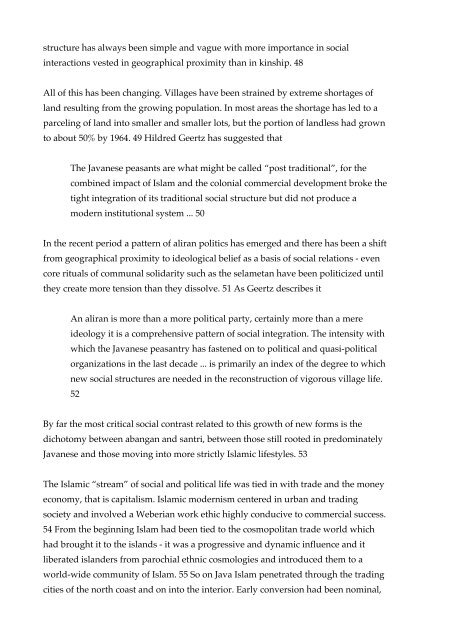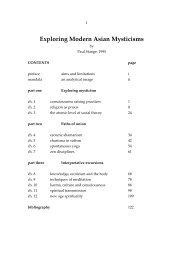Javanese Mystical and Marxist Dialectics - Paul Stange
Javanese Mystical and Marxist Dialectics - Paul Stange
Javanese Mystical and Marxist Dialectics - Paul Stange
You also want an ePaper? Increase the reach of your titles
YUMPU automatically turns print PDFs into web optimized ePapers that Google loves.
structure has always been simple <strong>and</strong> vague with more importance in socialinteractions vested in geographical proximity than in kinship. 48All of this has been changing. Villages have been strained by extreme shortages ofl<strong>and</strong> resulting from the growing population. In most areas the shortage has led to aparceling of l<strong>and</strong> into smaller <strong>and</strong> smaller lots, but the portion of l<strong>and</strong>less had grownto about 50% by 1964. 49 Hildred Geertz has suggested thatThe <strong>Javanese</strong> peasants are what might be called “post traditional”, for thecombined impact of Islam <strong>and</strong> the colonial commercial development broke thetight integration of its traditional social structure but did not produce amodern institutional system ... 50In the recent period a pattern of aliran politics has emerged <strong>and</strong> there has been a shiftfrom geographical proximity to ideological belief as a basis of social relations - evencore rituals of communal solidarity such as the selametan have been politicized untilthey create more tension than they dissolve. 51 As Geertz describes itAn aliran is more than a more political party, certainly more than a mereideology it is a comprehensive pattern of social integration. The intensity withwhich the <strong>Javanese</strong> peasantry has fastened on to political <strong>and</strong> quasi-politicalorganizations in the last decade ... is primarily an index of the degree to whichnew social structures are needed in the reconstruction of vigorous village life.52By far the most critical social contrast related to this growth of new forms is thedichotomy between abangan <strong>and</strong> santri, between those still rooted in predominately<strong>Javanese</strong> <strong>and</strong> those moving into more strictly Islamic lifestyles. 53The Islamic “stream” of social <strong>and</strong> political life was tied in with trade <strong>and</strong> the moneyeconomy, that is capitalism. Islamic modernism centered in urban <strong>and</strong> tradingsociety <strong>and</strong> involved a Weberian work ethic highly conducive to commercial success.54 From the beginning Islam had been tied to the cosmopolitan trade world whichhad brought it to the isl<strong>and</strong>s - it was a progressive <strong>and</strong> dynamic influence <strong>and</strong> itliberated isl<strong>and</strong>ers from parochial ethnic cosmologies <strong>and</strong> introduced them to aworld-wide community of Islam. 55 So on Java Islam penetrated through the tradingcities of the north coast <strong>and</strong> on into the interior. Early conversion had been nominal,




